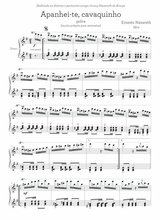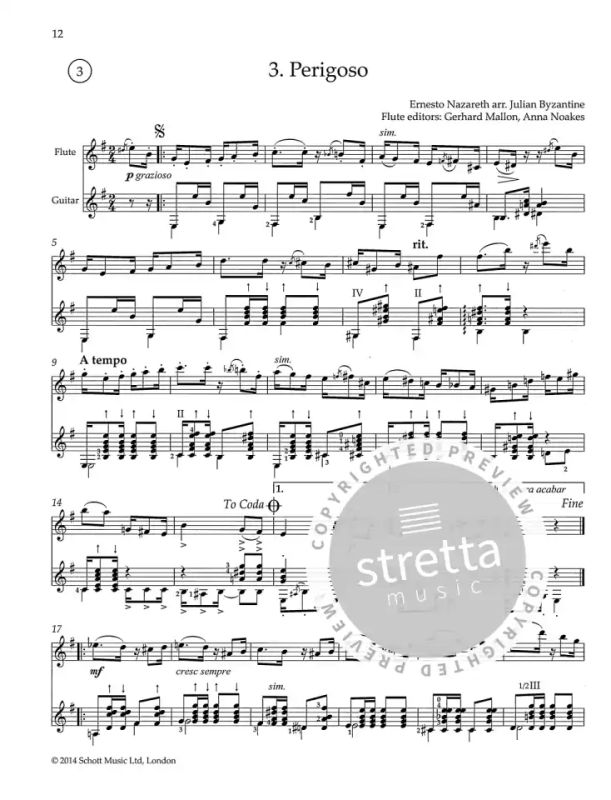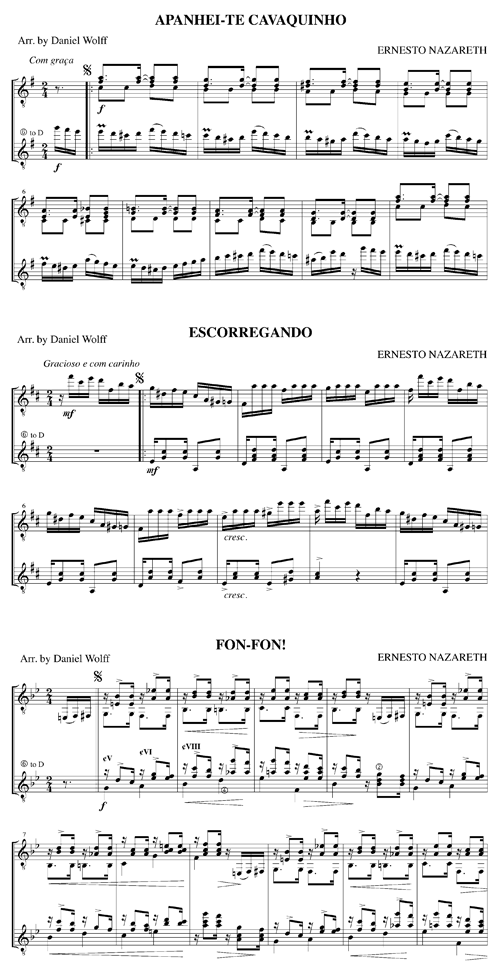

Nazareth remained in Rio de Janeiro for most of his life although in 1926 he undertook a hugely successful 11-month tour of São Paulo (visiting also Campinas, Sorocaba and Tatuí) and composed the tango Pauliceia, como és formosa! as thanks for the warm reception he received. Milhaud went on to borrow several of Nazareth’s melodies for his own Brazilian inspired compositions including Saudades do Brasil and the carnavalesque romp Le Boef sur le Toit. Darius Milhaud, who worked at the French embassy in the period 1917-18, waxed lyrically about Nazareth’s playing at the Odeon cinema, writing “his fluid, intriguing and sad style helped me better understand the Brazilian soul”. As a token of his high esteem, Villa-Lobos dedicated his first Choro for solo guitar to Nazareth who repaid the compliment with the dedication of concert study Improviso.

They would later play together in a small orchestra at the Odeon cinema.

In the same year he accompanied the young Villa-Lobos in possibly his first public appearance, playing Saint Saëns Le Cygne. In demand as a pianist, in 1909 he regularly played the piano in the waiting room of the luxurious Odeon cinema and such was his renown that people would flock to hear him rather than to watch the films. He would later do the same for other publishing houses, much to the delight of the public. Around this time he started to work as a ‘pianist-demonstrator’ at the music publishers Casa Vieira Machado & Cia, principally to play music for sale but also to write and review musical scores. Married and with a growing family, he published his first Brazilian tango Brejeiro in 1893 to instant acclaim and it remains to this day one of his most popular tangos. Nazareth continued to publish and by the age of twenty he was well-known locally as a composer, performer and piano teacher. His first success came with Não Caio n’Outra!!! (1881) reprinted several times, its proceeds allowed him to have ‘improvement’ lessons with a friend of Gottschalk’s, the American composer Charles Lucien Lambert who was based in Rio de Janeiro. Dedicated to his father, the title is a message (literally ‘Well you know’) of course his father well knew that his passion was for music. Nazareth published his first composition Você Bem Sabe (1877), a polka-lundu, when he was fourteen. Gottschalk, who died in Rio de Janeiro later the same year of yellow fever, is an often overlooked if uneven composer but he was a trailblazer in his own right, incorporating Creole melodies and syncopated African-Caribbean rhythms in his own compositions, anticipating later developments by decades. In 1869 at the age of six, he met the American composer and piano virtuoso Louis Moreau Gottschalk (1829-1869) at the Theatro Lyrico Fluminense where a family friend was tuning pianos for one of the composer’s extravagant concerts for 31 pianists and two orchestras. Like his idol Chopin, he wrote mostly for the piano and his music is almost without exception utterly charming and delightful to play.īorn in the Santo Cristo neighbourhood in the port area of Rio de Janeiro, Nazareth was the second of four children his father was a customs broker and his mother was a keen amateur pianist who gave the young Ernesto his first lessons on the piano. Nazareth is credited with inventing the Brazilian tango, a more suave form of its earnest Argentinian counterpart (or its sequinned export).
#APANHEI TE CAVAQUINHO GUITAR FLUTE SHEET MUSIC FULL#
Ernesto Nazareth, 1926.Įrnesto Júlio de Nazareth (pronounced Nazaré 1863 – 1934) was one of the first Brazilian composers to successfully integrate African-Brazilian rhythms into European genres such as waltzes, polkas, marches and quadrilles to produce an expressive, quintessentially Brazilian sound, full of bouncy syncopations, harmonic sophistication and technical ingenuity. If you are particularly fortunate, the musicians will play famous pieces from the early 20th century such as Odeon, Brejeiro and Apanhei-te, Cavaquinho! by Ernesto Nazareth, a composer whose seductive music evokes the urban sophistication of Rio de Janeiro’s Belle Époque, so much so that Heitor Villa-Lobos once described him as “the true incarnation of the Brazilian soul … he admirably and spontaneously conveys the vivid emotions of a people”. Comprising a guitar (played with some mesmerising finger work), a flute, sometimes a clarinet and a cavaquinho (a small four-stringed guitar), with drums and/or maracas, the group will often play a style of popular music called choro (or chorinho) music which is gentle, intimate and by turns languid or playful, in marked contrast to the more boisterous samba for which Rio de Janeiro is famous. One of the singular pleasures of sitting in the many street cafes and restaurants in Rio de Janeiro is to hear live instrumental music played by a small group of street musicians.


 0 kommentar(er)
0 kommentar(er)
